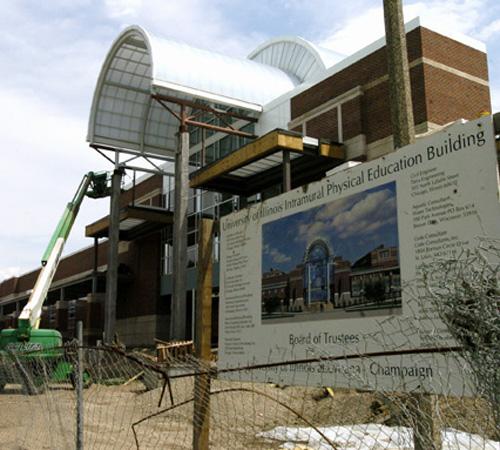August reopening in sight for ARC

Construction on ARC continues from the outside and can be seen from Peabody Drive. The front of the ARC is getting closer to the likeness of the sign that is posted at the base of the construction. Susan Kantor
June 3, 2008
With ever-present construction on campus, there is one project that is arguably most anticipated by students – the completion of the Intramural Physical Education Building.
IMPE, which will now become Activities and Recreation Center, or ARC, is scheduled to open on August 18 after approximately two yeas of construction.
“We are about a month away from completing construction on the building itself,” Associate Director of the Division of Campus Recreation Gary Miller said. “We are occupying about two and one half of the floors of the building right now. The rest, the other (about) two floors are what they are working on now.”
The renovated facility will have an approximately 45-day inspection period after construction finishes, with an estimated 7,000-8,000 people attending daily when the 340,000 square-foot building does open for student use.
Miller, who is one of the directors overseeing the construction of ARC, said the project has had its share of setbacks, but the main delays were due to its large scale and comprehensiveness.
Get The Daily Illini in your inbox!
“In general, I think, probably the largest delaying factor was the complexity of the actual project,” he said. “When you’re working with an existing facility and you’re renovating 220,000 square feet, that poses some conditions that don’t go as smooth as building new from the beginning.”
He said there has not been a single, big issue that has slowed the construction – rather there were a large number of small problems.
Although it will not affect the majority of the facility, or the August opening, damage to the roof that formerly covered the indoor pool and surrounding areas was found to be “more extensive than initially anticipated” by the University. The Board of Trustees has accordingly approved a $971,600 bid to demolish and replace the roof over that portion of the facility. Something Miller called a hindrance, but not a “big issue.”
The bid for the roof work comes in addition to the already $82.7 million allocated to rebuild the facility.
“We’re basically replacing the entire roof,” Miller said of the area of the building. “The rest of the roofs on the building, we took the tops off and replaced that, we didn’t go down to the steel beams, which is what we did (above the indoor pool).”
ARC’s renovation is coming at the same time, and same location, as the renovation of Memorial Stadium, a $120.9 million dollar project.
In addition, there is now pending work on Huff Hall to create a northern expansion on the facility; the addition will enable the University to offer a master’s degree in public health.
At time of press, financial terms were not available on the Huff project.
While the Memorial Stadium project is being funded by University bonds and gift funds, the ARC project will be getting portions of its funding from student fees. Exact monetary numbers were not available for how much would be coming from student fees and at time of press calls to University officials were not returned regarding them.
Student Trustee-elect Paul Schmidt said he does not support an increase, but he knows that given the University’s financial situation, something like an increase is understandable.
“I never want student fee money to pay for anything, student fees are kind of an odd concept because they are a way to almost supplement tuition,” Schmidt said about the funding origins. “However, I realize we’re in a crisis, a funding crisis. What is going to have to happen, long term, is there is going to have to be more money coming from the state of Illinois.
“We have no other alternative and you have a half-done building sitting there, and the longer that it sits there, the longer the students are without their facilities,” Schmidt said of ARC.
There does not seem to be a definite reason why there has been a proliferation of construction on campus. Miller said that there really is no explanation for the jump in building, but, regardless, because there is such a high demand for work now, the work force is being thinly spread out, which may be slowing production.
“The only thing about other projects on campus is that Champaign-Urbana only has a finite amount of skilled laborers,” he said.
“The more projects that are going on at any given time you have, the less labor you have. You can go on and on about the projects happening in the Champaign area; construction is very, very busy around this area and everyone wants to use the same skilled workers.”






